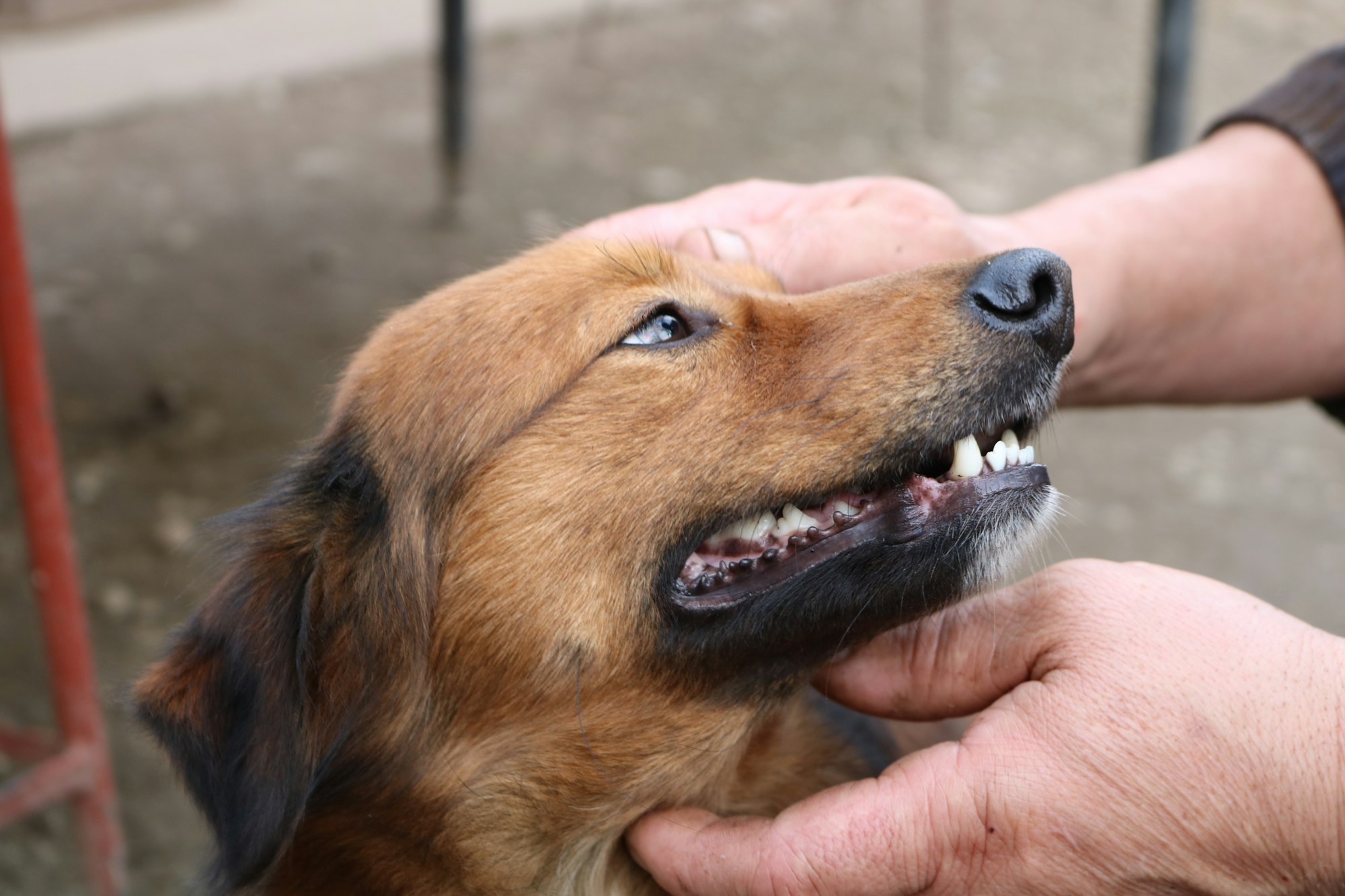Determining a dog's age can be a challenging task, especially if you have adopted a furry friend whose age is unknown. However, knowing your dog's age is crucial for providing appropriate care and ensuring their overall well-being. Age affects a dog's behavior, dietary needs, and health, which is why it is essential to determine their age accurately.

One of the most common ways to determine a dog's age is by looking at their teeth. Puppies have sharp, white teeth, while adult dogs have yellowed and worn-down teeth. By examining the wear and tear on a dog's teeth, you can estimate their age accurately. However, this method is not always accurate, as some dogs may have dental problems that affect the condition of their teeth.
Another way to determine a dog's age is by examining their eyes. As dogs age, their eyes may become cloudy or develop a bluish tint. However, this method is not always reliable, as some dogs may develop eye problems at a young age. Therefore, it is essential to use multiple methods to determine a dog's age accurately.
Determining Dog Age by Teeth
A dog's teeth can be a helpful indicator of their age. While it's not an exact science, there are a few things to look for when trying to determine a dog's age based on their teeth.

Puppy Teeth and Adult Teeth
Dogs have two sets of teeth in their lifetime - puppy teeth and adult teeth. Puppy teeth, also known as deciduous teeth, start to come in when a dog is around three to four weeks old and are usually all present by eight weeks. At around four months of age, these teeth start to fall out and are replaced by adult teeth. By the time a dog is seven to eight months old, all of their adult teeth should be present.
Tartar Accumulation and Wear
As a dog ages, their teeth may start to show signs of wear and tear. Older dogs may also have more tartar buildup on their teeth, which can make them appear yellow or brown. However, it's important to note that tartar buildup can also be a sign of poor dental hygiene, so it's not always a reliable indicator of age.
Periodontal Disease and Aging
Periodontal disease, which is a bacterial infection of the gums and teeth, is more common in older dogs. If a dog has significant periodontal disease, it may be a sign that they are older. However, it's important to note that periodontal disease can also be caused by poor dental hygiene, so it's not always a reliable indicator of age.
In conclusion, while a dog's teeth can provide some clues about their age, it's not an exact science. It's important to look at a variety of factors, including the dog's overall health and behavior, to get a more accurate estimate of their age.
Physical Signs of Aging in Dogs
As dogs age, their bodies go through various changes that can be observed through physical signs. These signs can help determine a dog's age, but it is important to note that they are not always accurate indicators. Here are some physical signs of aging in dogs:
Coat and Fur Changes
One of the most noticeable signs of aging in dogs is changes in their coat and fur. As dogs age, their fur may become thinner, duller, and more gray or white in color. Some dogs may also develop ridges or waves in their fur. These changes are most noticeable in long-haired breeds, but they can occur in all breeds.
Eye Clarity and Cataracts
Another sign of aging in dogs is changes in their eyes. As dogs age, their eyes may become cloudy or hazy, and they may develop cataracts. Cataracts are a common eye condition in older dogs and can cause vision problems. It is important to have a veterinarian examine your dog's eyes regularly to detect any eye problems early.
Muscle Tone and Body Shape
As dogs age, their muscle tone may decrease, and their body shape may change. Older dogs may become less active and have a harder time maintaining their weight. They may also develop a sagging belly or lose muscle tone in their hind legs. Regular exercise and a healthy diet can help maintain muscle tone and body shape in older dogs.
Paw Pads and Nail Conditions
Paw pads and nails can also provide clues to a dog's age. Older dogs may have thicker paw pads and longer nails that are more brittle and prone to breaking. They may also develop calluses on their paw pads from years of walking and running. Regular paw pad and nail care can help keep these areas healthy and comfortable for older dogs.
In conclusion, physical signs of aging in dogs can vary and are not always accurate indicators of a dog's age. However, observing these signs can help determine if a dog is entering their senior years and may require additional care and attention.
Behavioral and Lifestyle Indicators
When it comes to determining a dog's age, behavioral and lifestyle indicators can also be helpful. Here are some things to look out for:

Energy Levels and Exercise
Younger dogs tend to have more energy and require more exercise than older dogs. If a dog is constantly running around, playing, and seeking attention, they are likely younger. On the other hand, if a dog seems to tire easily, prefers to rest, and is less active, they may be older.
Appetite and Eating Habits
A dog's appetite and eating habits can also provide some clues about their age. Puppies tend to eat more frequently and require more food than adult dogs. Older dogs may experience a decrease in appetite or have difficulty eating due to dental issues or other health problems.
Sleep Patterns and Rest
Just like humans, dogs tend to sleep more as they get older. If a dog seems to nap frequently throughout the day and sleeps for longer periods at night, they may be older. Younger dogs tend to have more irregular sleep patterns and may be more active during the night.
It's important to note that behavioral and lifestyle indicators should not be used as the sole means of determining a dog's age. It's always best to consult with a veterinarian for a more accurate assessment.
Health-Related Aging Factors
As dogs age, they experience a variety of health-related aging factors that can affect their overall well-being. Here are some common health factors that can affect a dog's age:
Arthritis and Joint Problems
Arthritis and joint problems are common in older dogs and can cause a lot of pain and discomfort. Dogs with arthritis may have difficulty getting up and moving around, and they may be less active than they used to be. To help manage arthritis, it is important to keep your dog at a healthy weight and provide them with regular exercise. Some dogs may also benefit from joint supplements or pain medication.
Hearing Loss and Sensory Decline
As dogs age, their hearing and other senses may decline. This can make it difficult for them to hear commands or respond to their surroundings. It is important to keep your dog's ears clean and to provide them with regular veterinary check-ups to monitor their hearing and other sensory functions.
Dental Health and Diseases
Dental health is important for dogs of all ages, but it becomes even more important as they age. Older dogs are more prone to dental diseases such as periodontal disease, which can cause pain, infection, and tooth loss. To help maintain your dog's dental health, it is important to provide them with regular dental cleanings and to brush their teeth regularly.
Weight and Diet Changes
As dogs age, their metabolism slows down and they may be less active than they used to be. This can lead to weight gain and other health problems. To help manage your dog's weight, it is important to provide them with a healthy diet that is appropriate for their age and activity level. You may also need to adjust their feeding schedule or portion sizes to help them maintain a healthy weight.
Overall, it is important to be aware of the health-related aging factors that can affect your dog's well-being as they age. By providing them with proper care and attention, you can help ensure that they live a happy and healthy life.
Genetics and Breed-Specific Aging
Determining a dog's age can be a bit tricky, especially when it comes to adult dogs. However, genetics and breed-specific factors can provide some clues to a dog's age. Here are some things to keep in mind:
Small Breeds vs. Large Dog Breeds
In general, small breeds tend to live longer than large dog breeds. This is due to a number of factors, including the fact that smaller dogs have less strain on their joints and organs. Large dog breeds, on the other hand, tend to have shorter lifespans and may show signs of aging earlier on.
Genetic Lifespan Factors
Genetics can play a role in a dog's lifespan. Some breeds are simply predisposed to living longer than others. For example, the Australian Cattle Dog has a lifespan of around 12-15 years, while the Bernese Mountain Dog has a lifespan of around 7-10 years.
Common Breed-Specific Ailments
Certain breeds are more prone to certain health issues than others. For example, small breeds like Chihuahuas may develop dental problems as they age, while large breeds like Great Danes may be more prone to hip dysplasia. Knowing these breed-specific ailments can help determine a dog's age by looking for signs of these conditions.
Overall, while genetics and breed can provide some clues to a dog's age, it's important to remember that every dog is unique. Other factors like diet, exercise, and overall health can also play a role in a dog's lifespan.
Scientific Methods and Tools

DNA Tests for Age Estimation
One of the most accurate and reliable methods for determining a dog's age is through DNA testing. DNA testing can provide information about a dog's age by analyzing changes in its DNA methylation patterns. DNA methylation is a process that alters the activity of a DNA segment without changing its sequence. As a dog ages, its DNA methylation patterns change in predictable ways, and these changes can be used to estimate the dog's age with a high degree of accuracy.
Several companies offer DNA tests for age estimation, including Wisdom Panel and Embark. These tests require a sample of the dog's DNA, which can be collected using a cheek swab or blood sample. The DNA is then analyzed to determine the dog's age based on its methylation patterns. DNA testing is particularly useful for determining the age of dogs with unknown or uncertain backgrounds, such as rescue dogs or strays.
Advancements in Dog Aging Research
In recent years, there have been significant advancements in the field of dog aging research. Scientists are studying the biology of aging in dogs to gain a better understanding of the aging process and develop new methods for age estimation.
One promising area of research is the study of epigenetic changes in dogs. Epigenetic changes are modifications to the DNA that do not alter the DNA sequence but can affect gene expression and cellular function. Scientists are studying epigenetic changes in dogs to identify biomarkers that can be used to estimate a dog's age.
Another area of research is the development of machine learning algorithms for age estimation. Machine learning algorithms can analyze large datasets of dog DNA and other biological data to identify patterns and predict a dog's age with a high degree of accuracy.
Overall, these scientific methods and tools offer new and innovative ways to estimate a dog's age with greater accuracy and reliability.
Consulting with Veterinarians
Consulting with a veterinarian is the most reliable way to determine a dog's age. Veterinarians are trained to identify physical changes that occur as a dog ages, and can also take into account a dog's breed and medical history.
During a physical exam, a veterinarian will look for signs of aging such as graying fur, dental wear, and changes in mobility. They may also perform blood work and other diagnostic tests to assess a dog's overall health and determine appropriate care.
For senior dogs, regular check-ups with a veterinarian are especially important to detect and manage age-related health issues. Veterinarians can provide guidance on appropriate care for senior dogs, including diet and exercise recommendations, as well as medications and supplements that may be beneficial.
Overall, consulting with a veterinarian is the best way to accurately determine a dog's age and ensure they receive appropriate care throughout their life.
Life Stages of Dogs
Dogs go through several life stages, each with its own set of characteristics and needs. Understanding these stages can help you take better care of your furry friend.
Puppy to Adult Transition
Puppies are born deaf, blind, and toothless, and they rely on their mother for everything. As they grow, they become more independent and start exploring the world around them. At around 6-8 weeks of age, puppies are weaned and can eat solid food.
During the puppy stage, dogs go through rapid growth and development. They also reach sexual maturity between 6-12 months of age, depending on the breed. This is when dogs can start reproducing, but it's important to wait until they are fully grown and mature before breeding them.
Once dogs reach adulthood, their growth slows down, and they become more stable in terms of behavior and personality. Adult dogs require regular exercise, a balanced diet, and preventative healthcare to stay healthy.
Senior Dogs and Geriatric Care
As dogs age, they enter their senior years. This can vary depending on the breed, but generally, dogs are considered seniors at around 7-8 years of age. Senior dogs may experience a decline in physical and cognitive abilities, including sight, hearing, and memory.
Geriatric care is essential for senior dogs to maintain their quality of life. This includes regular check-ups with a veterinarian, a balanced diet, and appropriate exercise. Senior dogs may also require special accommodations, such as softer bedding or ramps to help them get around.
It's important to note that some dogs may reach a geriatric age, which is when they are over 12-14 years old. These dogs require even more specialized care and attention to ensure they are comfortable and happy in their golden years.

Understanding the life stages of dogs can help you provide the best care for your furry friend throughout their entire life.
Conclusion
In conclusion, understanding how to tell a dog's age is a valuable skill for any pet owner. By observing physical signs, behavior, and utilizing veterinary assistance, you can provide the best possible care for your furry companion as they age. Remember, each dog is unique, and tailoring their care to their individual needs ensures a happy and healthy life.
FAQs
- Q1: Can I accurately determine my dog's age with online tools?
- A: Online tools can provide estimates based on general factors, but a vet's assessment is more accurate.
- Q2: What special care do senior dogs need?
- A: Senior dogs may require adjusted diets, regular vet check-ups, and a comfortable living environment.
- Q3: Are there specific breeds that age more slowly?
- A: Yes, smaller breeds generally age more slowly than larger breeds.
- Q4: How can I manage arthritis in my aging dog?
- A: Consult with your vet for a tailored plan, which may include medication, diet, and exercise.
- Q5: Is it advisable to adopt an older dog if I have children?
- A: Older dogs can make great companions for families with children, as their temperaments are often well-established.




